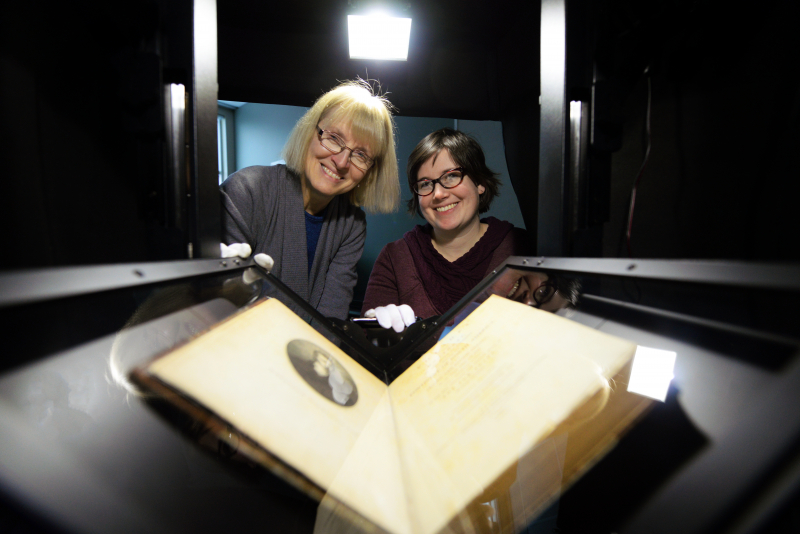Digitally Exploring Northern B.C.'s History
Archival research can be equal parts challenging and exhilarating. Challenging to pore over old land survey maps and delve into correspondence, but exhilarating to find those nuggets of information that connect key aspects of a research project. Now, an anonymous contribution to the Northern Leadership Campaign is making many of the books, maps and records at the archives more accessible to researchers across B.C. and around the world.

Meticulously digging through the trove of material available at the Northern BC Archives and Special Collections takes planning, patience and persistence.
Archival research can be equal parts challenging and exhilarating; challenging to pore over old land survey maps and delve into correspondence, but exhilarating to find those nuggets of information that connect key aspects of a research project.
Now, an anonymous contribution to the University of Northern British Columbia’s Northern Leadership Campaign is making many of the books, maps and records at the archives more accessible to researchers across British Columbia and around the world. A digitization project two years in the making allowed the archives to create the Northern BC Digital Collection, putting 204 books and pamphlets, 84 maps and 148 newspapers online, strengthening the University’s research and teaching excellence.
“This is part of a long, ongoing series of projects to make our holdings more accessible to our students and faculty, particularly at our regional campuses,” says Head of Archives & Special Collections Ramona Rose. “Many of the special collections were books and map material that were only accessible to students and faculty at the Prince George campus.”
Among the digitized material is one of the archive’s oldest holding, a first edition of Alexander Mackenzie’s 1801 book Voyages from Montreal. The book details Mackenzie’s travels throughout what is now British Columbia and includes interesting annotations and colour maps.
UNBC History Professor Dr. Jonathan Swainger and his students have accessed Shoulder Strap, a magazine produced by the British Columbia Province Police beginning in the 1930s.
“What’s so nice about having something like Shoulder Strap on hand is that students are provided the means to read these depictions produced by the police without having the intervening voice of a scholar pointing out particular details,” Swainger explains. “Thus the student’s curiosity and interest drives their research.”
The collection includes five volumes of the magazine, produced between 1938 and 1956.
“As much as historical inquiry is about developing empathy for others, Shoulder Strap is extraordinarily useful in that for B.C.-based students, they can see places and people who seem familiar while, at the same time, those same historical actors view the world in striking different ways,” Swainger says. “In working to understand these people, students are thus provided with a lesson in developing empathy for those around them in their own times.”
The Campaign contribution allowed the archives to dedicate nearly two years of staff time to go through the holdings and determine what could be digitized and what should be part of the online collection.
“We conducted user studies to find out how researchers would use the resource and what items would be most useful,” says Archivist/Librarian Kim Stathers, who led the project from inception to completion. “For instance, faculty members told us they would like to have more First Nations ethnologies.”
Some of the digitization work was done at the Prince George campus, but most of the material was shipped to Vancouver where a large format scanner at the Irving K Barber Learning Centre handled the digitization of maps, newspapers and other items. The digitization process itself took nearly a year to complete and once it was done, Stathers worked with the material to prepare for the online launch this past summer.
The collection is accessible to the public for free and is not limited to researchers at post-secondary institutions. For instance, School District No. 57 (Prince George) has included a link to the collection through its District Resource Centre.
The project is also having an impact globally.
Take Tom Özden-Schilling, an Assistant Professor of Anthropology at John Hopkins University in Baltimore. He knows just how valuable the curated material at the Northern BC Archives can be for his work on environmental knowledge and land use changes in Northern B.C. He spent a significant amount of time in the summer of 2017 in Prince George, accessing documents from the archive, but the digitization project allows him to continue his research without having to travel halfway across the continent.
“Any work you do at an archive is an iterative process,” Özden-Schilling says. “Often the questions come later and you want to go back and take a second look at some of the material.”
The digitized maps have proved to be of particular interest to Özden-Schilling, as he has integrated some of his favourites into his lectures.
“I have been able to integrate the photographs into interactive presentations,” he says. “For instance, I am able to show my students what a remote research station in a research forest in Northern British Columbia looks like.”
With hundreds of documents, including the entire run of the Cassiar Courier newspaper already online, there is plenty of information for researchers to chew on. But this is just the beginning and a second phase is already underway, thanks to another contribution from the same private foundation.
“We’ve received requests from community researchers asking if additional rare print holdings will be digitized, such as city directories,” Rose says. “So we see many opportunities for this on-line portal to become an ongoing resource for Northern BC research work.”
